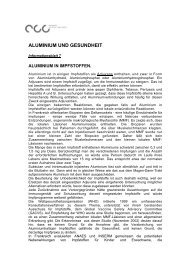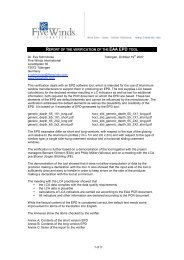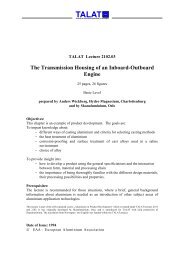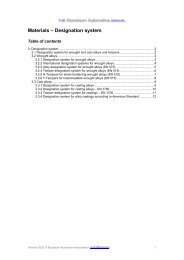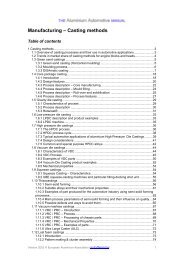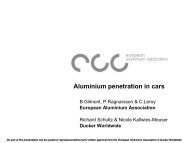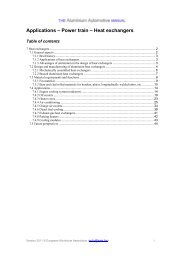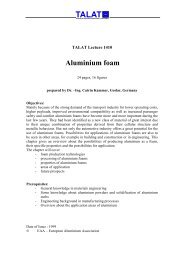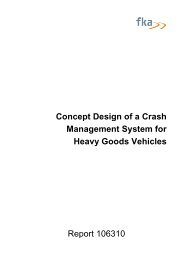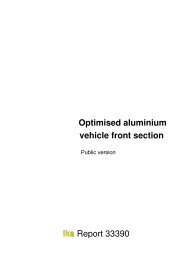aluminium in commercial vehicles - European Aluminium Association
aluminium in commercial vehicles - European Aluminium Association
aluminium in commercial vehicles - European Aluminium Association
Create successful ePaper yourself
Turn your PDF publications into a flip-book with our unique Google optimized e-Paper software.
118 EUROPEAN ALUMINIUM ASSOCIATION ALUMINIUM IN COMMERCIAL VEHICLES CHAPTER VIII<br />
4. Plasma MIG weld<strong>in</strong>g<br />
This process comb<strong>in</strong>es the high<br />
melt<strong>in</strong>g capacity of the MIG<br />
process with the nearly ideal<br />
shape of the plasma arc and its<br />
very good gas shield for the<br />
weld<strong>in</strong>g pool. The result is an<br />
extremely good quality of welds,<br />
especially the absence of porosity.<br />
The plasma arc is ma<strong>in</strong>ta<strong>in</strong>ed<br />
between the plasma r<strong>in</strong>g nozzle<br />
5. Laser weld<strong>in</strong>g<br />
Laser weld<strong>in</strong>g of <strong>alum<strong>in</strong>ium</strong><br />
alloys is develop<strong>in</strong>g rapidly parallel<br />
with the development of ever<br />
grow<strong>in</strong>g power of laser sources.<br />
There are on one side CO lasers 2<br />
of up to 20 KW and more and<br />
Nd:YAG lasers of 6 KW and<br />
more. With the CO laser, the ori-<br />
2<br />
entation of the beam is limited,<br />
whereas with the Nd:YAG laser<br />
optical fibres allow to br<strong>in</strong>g the<br />
laser beam directly to the weld<br />
zone. This gives high flexibility<br />
especially for robot weld<strong>in</strong>g. The<br />
high reflectivity of <strong>alum<strong>in</strong>ium</strong><br />
makes it necessary to <strong>in</strong>stall the<br />
laser equipment <strong>in</strong> a separate<br />
of the torch and the work piece,<br />
the MIG arc is <strong>in</strong> the centre of<br />
the plasma arc. Both arcs have<br />
the same polarity where the high<br />
k<strong>in</strong>etic energy of the plasma arc<br />
destroys the oxide layer on the<br />
work piece. Mechanical removal<br />
of the oxide layer can be dispensed<br />
with.<br />
room, where dur<strong>in</strong>g operation of<br />
the equipment, nobody without<br />
adequate eye protection has<br />
access. The sensor which emits<br />
the signals necessary for the<br />
motion control of the laser beam<br />
must be very effective for not<br />
be<strong>in</strong>g disturbed by reflections.<br />
The process is ma<strong>in</strong>ly used for<br />
th<strong>in</strong> gauge materials (1 – 4 mm)<br />
and the pieces to be jo<strong>in</strong>ed must<br />
fit perfectly as is the case e.g. <strong>in</strong><br />
the production of tailored blanks<br />
for the car <strong>in</strong>dustry.<br />
The process is well suited for<br />
applications with high requirements<br />
for tightness and surface<br />
aspect. It is possible to carry out<br />
butt welds of up to 10 mm thickness<br />
<strong>in</strong> one pass with the edge<br />
preparation <strong>in</strong> V. The weld<strong>in</strong>g<br />
speed is higher than for MIG<br />
weld<strong>in</strong>g.<br />
The achievable weld<strong>in</strong>g speeds<br />
are up to 12m/m<strong>in</strong> with thickness<br />
of around 1mm and still<br />
1-3 m/m<strong>in</strong> with thicknesses<br />
between 1.5 and 3 mm.<br />
Compared with standard arc<br />
weld<strong>in</strong>g, laser weld<strong>in</strong>g allows the<br />
production of components with<br />
reduced geometrical distortions<br />
and residual stresses, as well as<br />
narrower heat affected zone, a<br />
direct consequence of the high<br />
work speed and thus the low<br />
heat <strong>in</strong>put.<br />
The laser weld<strong>in</strong>g process is<br />
preferably used with filler wire<br />
for <strong>alum<strong>in</strong>ium</strong> alloys.



